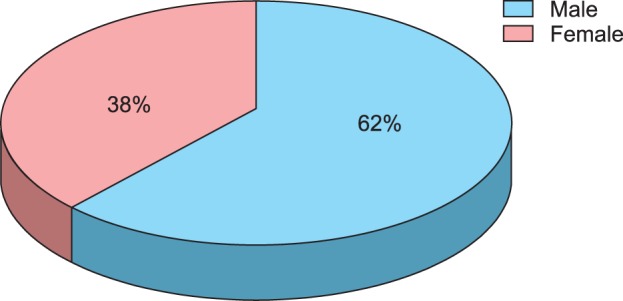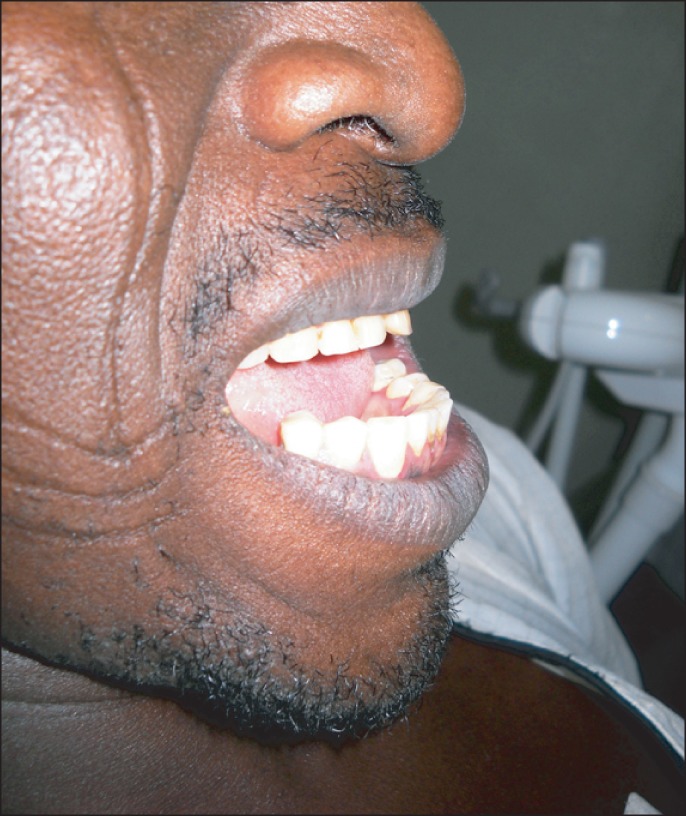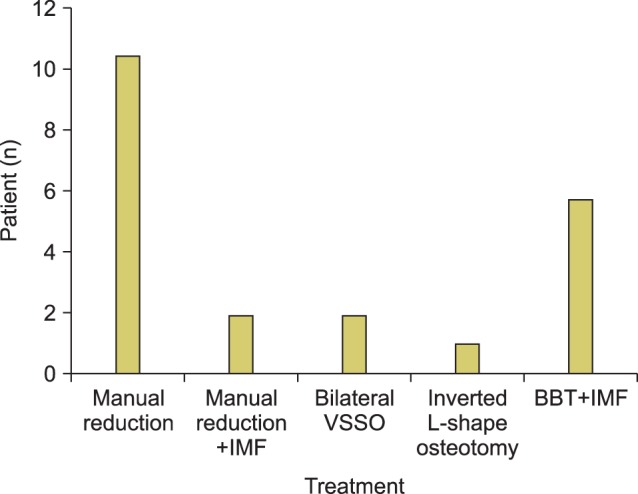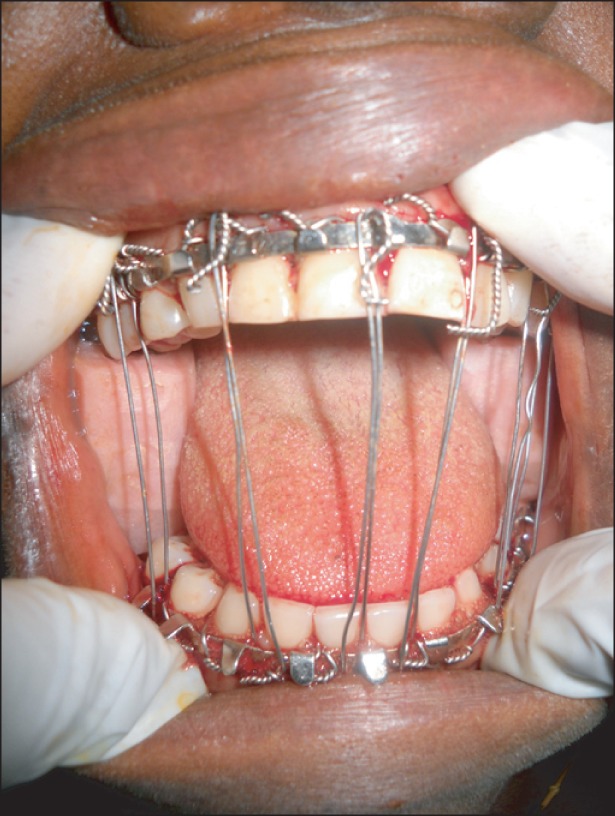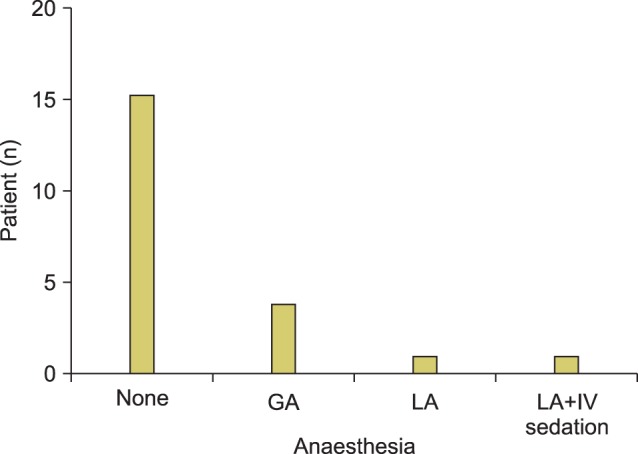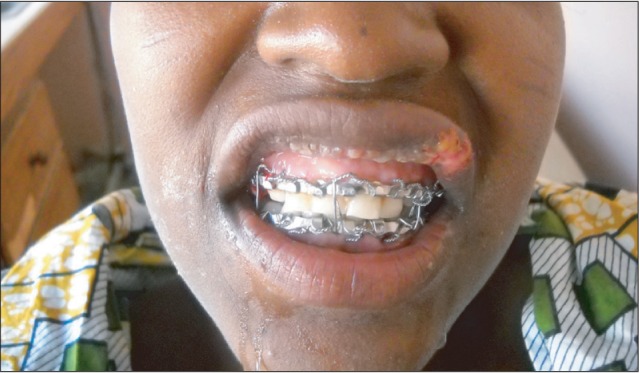J Korean Assoc Oral Maxillofac Surg.
2014 Jun;40(3):111-116.
Temporomandibular joint dislocation: experiences from Zaria, Nigeria
- Affiliations
-
- 1Department of Oral and Maxillofacial Surgery, Ahmadu Bello University Teaching Hospital, Shika-Zaria, Kaduna, Nigeria. row_prof@yahoo.com
Abstract
OBJECTIVES
Dislocation of the temporomandibular joint may occur for various reasons. Although different invasive methods have been advocated for its treatment, this study highlights the value of non-invasive treatment options even in chronic cases in a resource-poor environment.
MATERIALS AND METHODS
A seven-year retrospective analysis of all patients managed for temporomandibular joint dislocation in our department was undertaken. Patient demographics, risk factors associated with temporomandibular joint dislocation and treatment modalities were retrieved from patient records.
RESULTS
In all, 26 patients were managed over a seven-year period. Males accounted for 62% of the patients, and yawning was the most frequent etiological factor. Conservative treatment methods were used successfully in 86.4% of the patients managed. Two (66.7%) of the three patients who needed surgical treatment developed complications, while only one (5.3%) patient who was managed conservatively developed complications.
CONCLUSION
Temporomandibular joint dislocation appears to be associated with male sex, middle age, yawning, and low socio-economic status, although these observed relationships were not statistically significant. Non-invasive methods remain an effective treatment option in this environment in view of the low socio-economic status of the patients affected.
Keyword
MeSH Terms
Figure
Reference
-
1. Last RJ. Temporomandibular joint. In : Last RJ, McMinn RMH, editors. Last's anatomy regional and applied. 9th ed. Edinburgh: Churchill Livingstone;1994. p. 523–525.2. Osborn JW. The disc of the human temporomandibular joint: design, function and failure. J Oral Rehabil. 1985; 12:279–293. PMID: 3862791.
Article3. Koolstra JH. Dynamics of the human masticatory system. Crit Rev Oral Biol Med. 2002; 13:366–376. PMID: 12191962.
Article4. Ingawalé S, Goswami T. Temporomandibular joint: disorders, treatments, and biomechanics. Ann Biomed Eng. 2009; 37:976–996. PMID: 19252985.
Article5. Caminiti MF, Weinberg S. Chronic mandibular dislocation: the role of non-surgical and surgical treatment. J Can Dent Assoc. 1998; 64:484–491. PMID: 9737079.6. Schwartz AJ. Dislocation of the mandible: a case report. AANA J. 2000; 68:507–513. PMID: 11272957.7. Cardoso AB, Vasconcelos BC, Oliveira DM. Comparative study of eminectomy and use of bone miniplate in the articular eminence for the treatment of recurrent temporomandibular joint dislocation. Braz J Otorhinolaryngol. 2005; 71:32–37. PMID: 16446889.
Article8. Lovely FW, Copeland RA. Reduction eminoplasty for chronic recurrent luxation of the temporomandibular joint. J Can Dent Assoc. 1981; 47:179–184. PMID: 7013948.9. Sang LK, Mulupi E, Akama MK, Muriithi JM, Macigo FG, Chindia ML. Temporomandibular joint dislocation in Nairobi. East Afr Med J. 2010; 87:32–37. PMID: 23057301.
Article10. Akinbami BO. Evaluation of the mechanism and principles of management of temporomandibular joint dislocation. Systematic review of literature and a proposed new classification of temporomandibular joint dislocation. Head Face Med. 2011; 7:10. PMID: 21676208.
Article11. Ugboko VI, Oginni FO, Ajike SO, Olasoji HO, Adebayo ET. A survey of temporomandibular joint dislocation: aetiology, demographics, risk factors and management in 96 Nigerian cases. Int J Oral Maxillofac Surg. 2005; 34:499–502. PMID: 16053868.
Article12. Candirli C, Yüce S, Cavus UY, Akin K, Cakir B. Autologous blood injection to the temporomandibular joint: magnetic resonance imaging findings. Imaging Sci Dent. 2012; 42:13–18. PMID: 22474643.
Article13. Güven O. Management of chronic recurrent temporomandibular joint dislocations: a retrospective study. J Craniomaxillofac Surg. 2009; 37:24–29. PMID: 18996023.14. Chhabra S, Chhabra N. Recurrent bilateral TMJ dislocation in a 20-month-old child: a rare case presentation. J Indian Soc Pedod Prev Dent. 2011; 29(6 Suppl 2):S104–S106. PMID: 22169834.
Article15. Whiteman PJ, Pradel EC. Bilateral temporomandibular joint dislocation in a 10-month-old infant after vomiting. Pediatr Emerg Care. 2000; 16:418–419. PMID: 11138886.
Article16. Ozcelik TB, Pektas ZO. Management of chronic unilateral temporomandibular joint dislocation with a mandibular guidance prosthesis: a clinical report. J Prosthet Dent. 2008; 99:95–100. PMID: 18262009.
Article17. Wahab NU, Warraich RA. Treatment of TMJ recurrent dislocation through eminectomy: a study. Pakistan Oral Dent J. 2008; 28:25–28.18. Vasconcelos BC, Porto GG, Lima FT. Treatment of chronic mandibular dislocations using miniplates: follow-up of 8 cases and literature review. Int J Oral Maxillofac Surg. 2009; 38:933–936. PMID: 19467842.
Article19. Cascarini L, Cameron MG. Bilateral TMJ dislocation in a 23-month-old infant: a case report. Dent Update. 2009; 36:312–313. PMID: 19585855.
Article20. Anantharam B, Chahal N, Stephens N, Senior R. Temporo-mandibular joint dislocation: an unusual complication of transoesophageal echocardiography. Eur J Echocardiogr. 2010; 11:190–191. PMID: 19939814.
Article21. Sosis M, Lazar S. Jaw dislocation during general anaesthesia. Can J Anaesth. 1987; 34:407–408. PMID: 3608062.
Article22. Pradhan L, Jaisani MR, Sagtani A, Win A. Conservative management of chronic TMJ dislocation: an old technique revived. J Maxillofac Oral Surg. 2013; doi: 10.1007/s12663-013-0476-9.
Article23. Adekeye EO, Shamia RI, Cove P. Inverted L-shaped ramus osteotomy for prolonged bilateral dislocation of the temporomandibular joint. Oral Surg Oral Med Oral Pathol. 1976; 41:568–577. PMID: 1063959.
Article24. Oliphant R, Key B, Dawson C, Chung D. Bilateral temporomandibular joint dislocation following pulmonary function testing: a case report and review of closed reduction techniques. Emerg Med J. 2008; 25:435–436. PMID: 18573960.
Article25. Tohyama H, Kurita H, Uehara S, Kurashina K. Retrospective analysis of clinical findings of TMJ dislocation and treatment. Shinsu Med J. 2008; 56:191–194.26. Zanoteli E, Yamashita HK, Suzuki H, Oliveira AS, Gabbai AA. Temporomandibular joint and masticatory muscle involvement in myotonic dystrophy: a study by magnetic resonance imaging. Oral Surg Oral Med Oral Pathol Oral Radiol Endod. 2002; 94:262–271. PMID: 12221397.
Article27. Vázquez Bouso O, Forteza González G, Mommsen J, Grau VG, Rodríguez Fernández J, Mateos Micas M. Neurogenic temporomandibular joint dislocation treated with botulinum toxin: report of 4 cases. Oral Surg Oral Med Oral Pathol Oral Radiol Endod. 2010; 109:e33–e37. PMID: 20219583.
Article28. Zakariaei Z, Taslimi S, Tabatabaiefar MA, Arghand Dargahi M. Bilateral dislocation of temporomandibular joint induced by haloperidol following suicide attempt: a case report. Acta Med Iran. 2012; 50:213–215. PMID: 22418992.29. Solomon S, Gupta S, Jesudasan J. Temporomandibular dislocation due to aripiprazole induced dystonia. Br J Clin Pharmacol. 2010; 70:914–915. PMID: 21175449.
Article30. Kodama M, Fujiwara M. Risperidone-induced dislocation of the temporomandibular joint. J Clin Psychiatry. 2012; 73:176. PMID: 22401477.
Article31. Ibrahim ZY, Brooks EF. Neuroleptic-induced bilateral temporomandibular joint dislocation. Am J Psychiatry. 1996; 153:293–294. PMID: 8561217.
- Full Text Links
- Actions
-
Cited
- CITED
-
- Close
- Share
- Similar articles
-
- Unrecognized Bilateral Dislocation of Temporomandibular Joint during Orotracheal Intubation
- Dislocation of the Bilateral Temporomandibular Joint due to Generalized Tonic-Clonic Seizures
- Baekward Dislocation of Temporomandibular Joint during Induction of Anesthesia
- SURGICAL CORRECTION OF RECURRENT HABITUAL TEMPOROMANDIBULAR JOINT DISLOCATION
- Condylar Hyperplasia with Long-standing Temporomandibular Joint Dislocation

